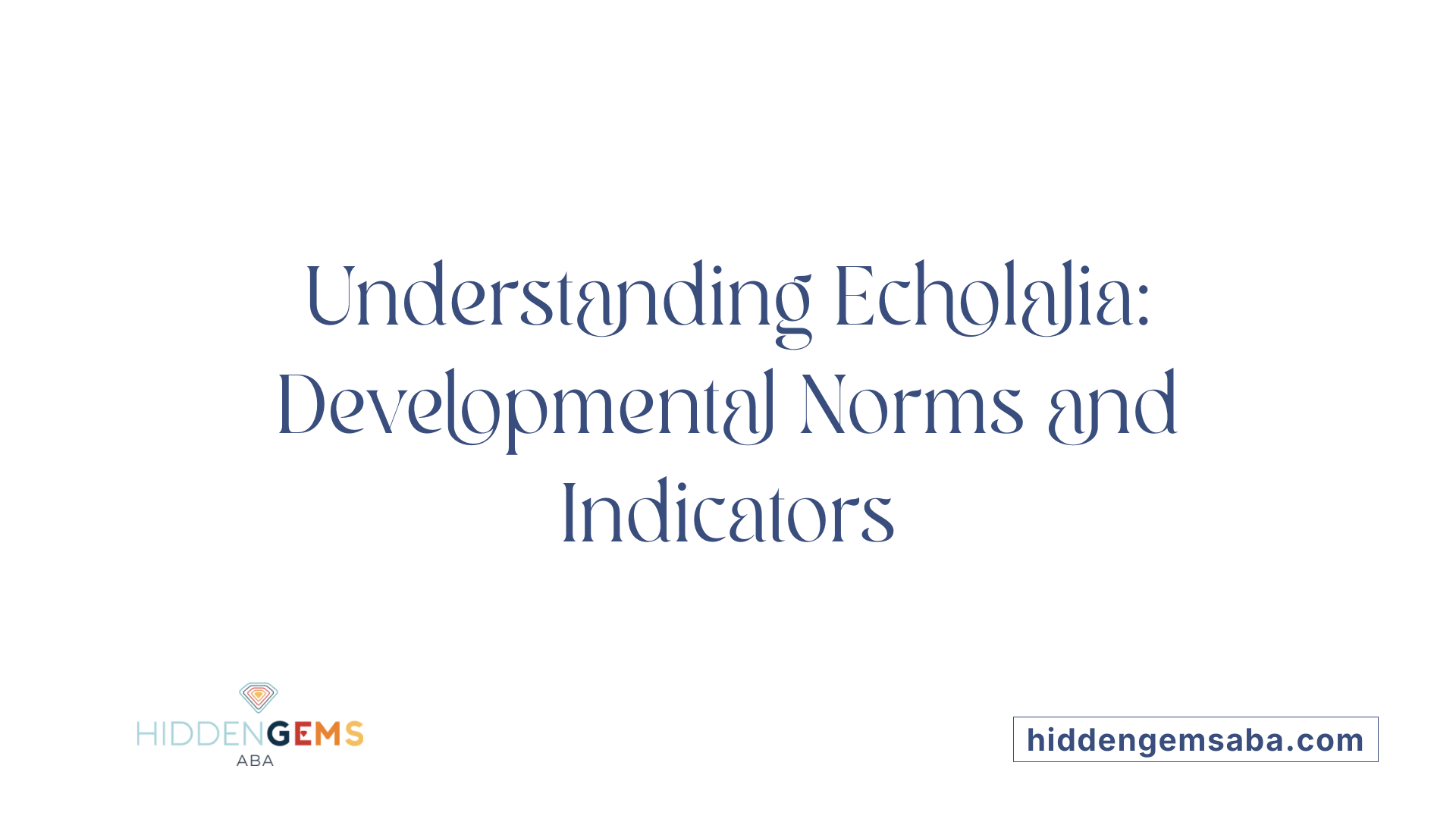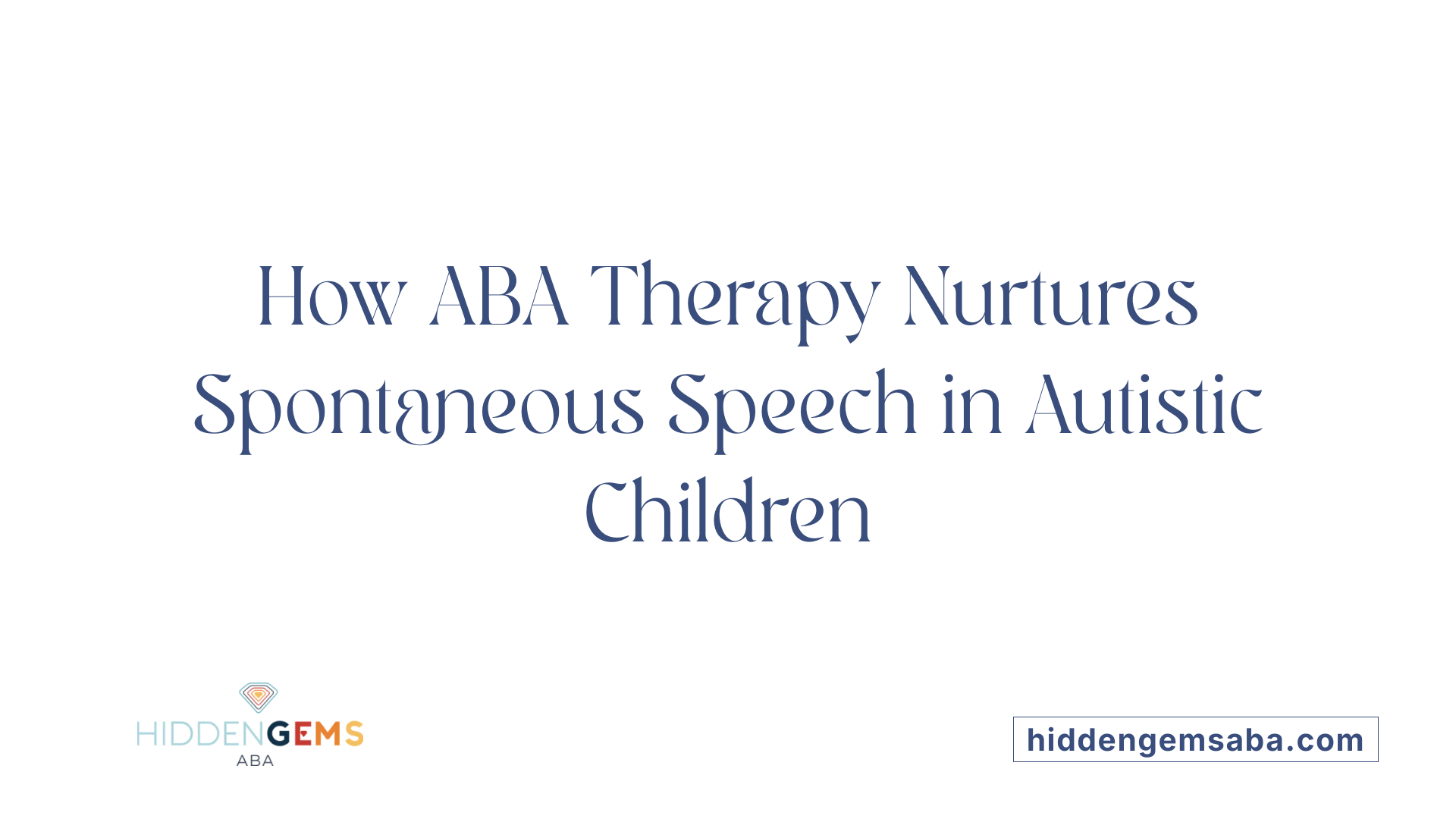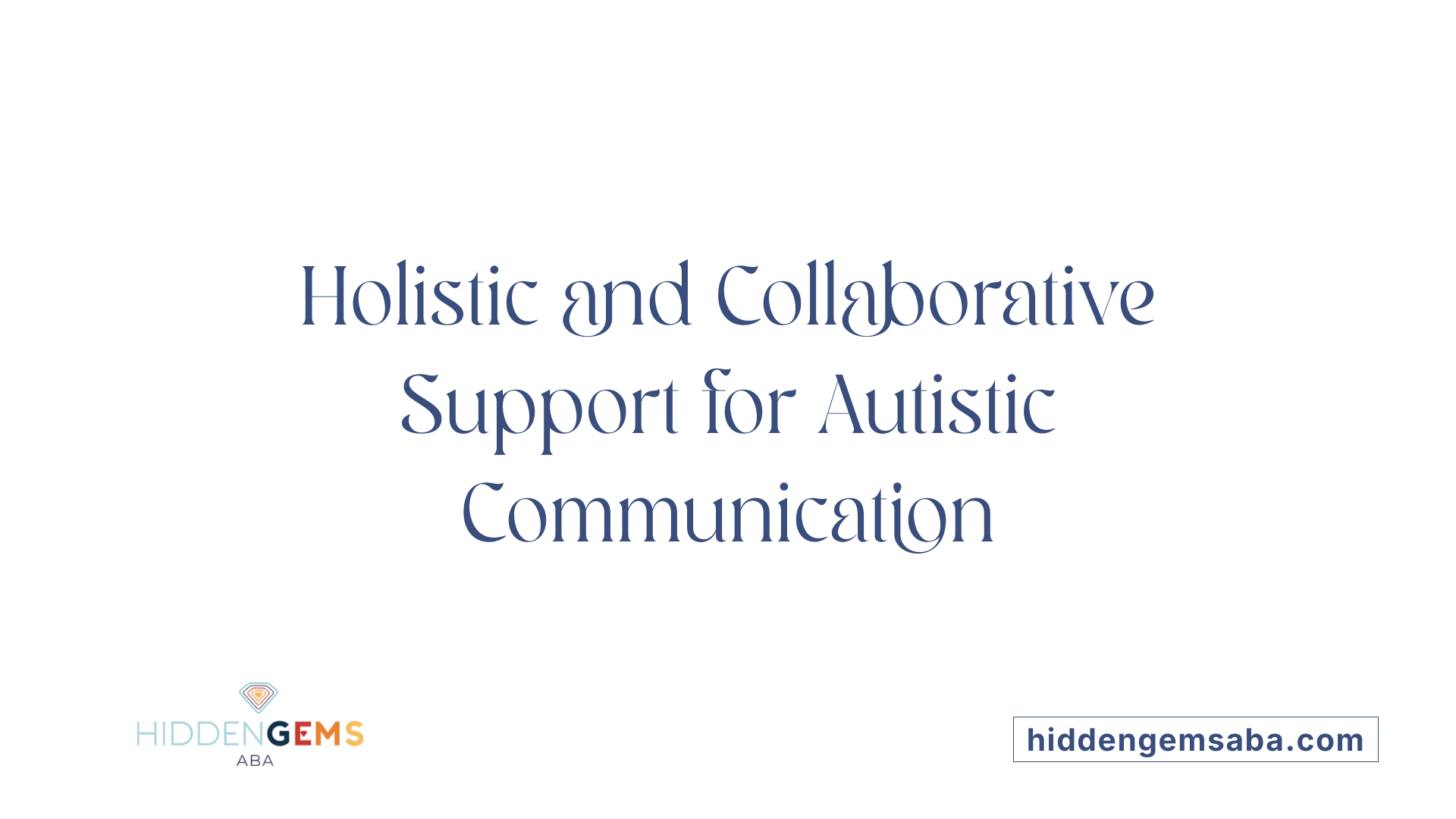Exploring Why Your Autistic Child Repeats Everything You Say
Many parents of autistic children notice their child often repeats words or phrases spoken by others, a behavior known as echolalia. This repetition can prompt concern yet is a natural part of language development and communication in many autistic children. Understanding echolalia, why it occurs, and how therapeutic interventions such as Applied Behavior Analysis (ABA) can help, is key to supporting your child's communication growth and social interaction.
What is Echolalia and Why Does It Occur in Autism?

Definition of echolalia
Echolalia is the repetition or echoing of words or sounds that someone else says. It is a natural part of language development, especially in young children who are learning how to communicate.
Types of echolalia: immediate, delayed, unmitigated, mitigated
Echolalia comes in several forms. Immediate echolalia occurs when a child repeats what they just heard, almost right away or after a short delay. Delayed echolalia happens when a child repeats words or phrases hours or even days later, often from memory or recordings like TV shows.
Furthermore, echolalia can be unmitigated, where the repetition is exact, or mitigated, where the repeated phrase is altered or adapted slightly. Recognizing these types helps in understanding the child's communication style.
Echolalia as a normal developmental step
For most children, echolalia is a normal and important phase in acquiring language skills. Typically, echolalia decreases by age 3 or 4 as children begin to use spontaneous speech. However, in children with autism spectrum disorder (ASD), echolalia often persists longer.
Prevalence of echolalia in autistic children
Echolalia is highly prevalent in autistic children, especially those over age 3 who can speak. Studies show that up to 80% of children with autism who use spoken language exhibit echolalia. This repetition can be a helpful part of their communication process.
Functional roles of echolalia
In autism, echolalia is not just meaningless repetition; it often serves important purposes. Children may use it to express needs, answer questions, affirm ideas, initiate social interactions, or self-soothe in stressful situations. Understanding the function behind the echolalic speech is vital for supporting the child’s communication development.
Why does my autistic child repeat everything I say?
Your child is engaging in echolalia, repeating phrases they have heard. This is a common language development behavior in autism and can serve various roles—from communicating requests to coping with sensory overload. Rather than just echoing, it often helps your child connect with others and build their speech skills.
Different Forms and Functions of Echolalia in Autism

Immediate vs Delayed Echolalia
Echolalia in autistic children appears mainly as immediate or delayed repetition. Immediate echolalia involves repeating words or phrases almost right away after hearing them. On the other hand, delayed echolalia occurs hours or even days later, often repeating phrases from TV shows or conversations heard previously.
Unmitigated vs Mitigated Repetition
Repetition can also be unmitigated, where the child repeats the phrase exactly as heard, or mitigated, where some alterations or changes in wording happen during the echo. Both types serve important roles in language expression and understanding.
Communication and Non-Communicative Functions
Echolalia is not only about mimicking sounds. It plays a communicative function—children use it to ask for things, respond to questions, initiate interaction, take conversational turns, or affirm answers. At times, it also serves non-communicative purposes, such as self-regulation or memory reinforcement.
Echolalia as Self-Soothing or Interaction Tool
For many autistic children, echolalia acts as a coping mechanism. Repeating familiar phrases can provide comfort and reduce stress in overwhelming environments, helping them self-soothe. Additionally, it can be a way to engage socially, serving as a stepping stone toward more spontaneous communication.
How Echolalia Supports Language Development
Even though echolalia involves repetition, it supports language growth by allowing children to practice sounds and phrases in meaningful contexts. Through therapy and guidance, children learn to use echolalia as a bridge to develop clearer and more flexible language skills, enhancing their overall communication.
How does echolalia function in autistic children's communication?
Echolalia in autistic children serves multiple communicative functions, such as requesting, affirming, or initiating interactions, and can also act as a coping mechanism for self-soothing in stressful situations. It is often a bridge that helps develop more flexible and spontaneous language use.
When Does Echolalia Signal Atypical Development?

Typical age range for echolalia in toddlers
Echolalia is a common and natural part of early language development. Most toddlers exhibit this behavior as they learn to speak, typically showing echolalia that diminishes by age 3 to 4. During this time, children echo words and phrases they hear, which helps them practice and understand language.
Persistence of echolalia beyond age 3
While echolalia is expected in very young children, persistent repetition of words or phrases beyond age 3 may raise concerns. In typical development, echolalia decreases as children begin to use spontaneous and flexible language. If echolalia continues after this period, it often signals delays in language skills or atypical developmental patterns.
Relation to autism spectrum disorder
Echolalia is especially common among children with autism spectrum disorder (ASD). Up to 75-80% of autistic children who speak exhibit echolalia, often lasting longer than in typically developing peers. In these cases, echolalia can serve as a communication tool, a coping mechanism, or a bridge toward more advanced language use.
Indicators of delayed or atypical language development
Persistent echolalia beyond the toddler years combined with other signs—such as failing to initiate meaningful verbal interaction, using overly elaborate or odd language, or avoiding eye contact—may indicate atypical language development. These indicators highlight the need for professional evaluation and tailored interventions.
Differentiating typical from atypical echolalia
Typical echolalia is immediate, declining as language skills improve, and serves exploratory or learning functions. Atypical echolalia, often observed in ASD, may be delayed, serve repetitive or non-communicative purposes, and persist without the usual progression toward flexible language. Understanding these differences aids in identifying children who need additional support.
When should persistent echolalia raise concerns?
Echolalia is typical in toddlers but usually diminishes by age 3 or 4 in typical development. If echolalia persists beyond this age, especially in autistic children, it can indicate atypical language development and the need for targeted intervention to support communication skills.
How ABA Therapy Supports Children with Echolalia

What is Applied Behavior Analysis (ABA) therapy?
ABA therapy is a scientific and evidence-based treatment designed to modify behavior by applying principles of learning. It focuses on enhancing positive, useful behaviors and reducing those that interfere with learning or social functioning. Certified behavior analysts develop personalized programs tailored to a child's unique needs.
ABA Principles and Behavior Modification Techniques
ABA uses strategies such as positive reinforcement, prompting, modeling, and structured teaching to encourage skill acquisition. It also employs data-driven approaches to monitor progress and adjust interventions.
How ABA Targets Communication Skills
ABA therapy directly addresses communication by breaking down language into achievable steps. For children displaying echolalia, ABA helps identify when repetitive speech serves a purpose—such as requesting or self-soothing—and builds on these functions to develop more flexible and spontaneous language.
Using ABA to Shape Echolalic Speech Towards Functional Language
Through repeated practice and reinforcement, ABA guides children to move from mere repetition of heard phrases toward generating their own meaningful responses. Techniques include prompting alternative verbal behaviors, modeling functional language, and teaching appropriate contexts for expression.
Role of Individualized ABA Programs
Each child’s echolalia patterns and communication goals are unique. ABA programs are customized based on assessments, ensuring interventions suit the child's developmental level and target specific behaviors. This individualized approach maximizes progress toward clearer communication and social interaction.
The Impact of ABA Therapy on Communication and Behavior in Autism

How does ABA therapy help individuals with autism?
ABA (Applied Behavior Analysis) therapy supports individuals with autism by teaching new skills that span communication, socialization, and daily living activities. It uses evidence-based methods to reinforce positive behaviors and reduce those that are challenging, ultimately enhancing independence and life quality.
ABA methods to teach new skills
ABA employs systematic teaching techniques including prompting and shaping to help children learn appropriate behaviors and communication. For example, therapists model desired responses and gradually encourage children to use their own words rather than repeating or echoing.
Positive reinforcement and prompting
Consistent positive reinforcement—such as praise or tangible rewards—encourages the repetition of desirable behaviors. Prompting guides the child through steps toward correct responses, which are then reinforced to build skills progressively.
ABA's ABC model (Antecedent, Behavior, Consequence)
A fundamental part of ABA is analyzing behavior through the ABC model:
- Antecedent: What happens before the behavior?
- Behavior: The specific action or response.
- Consequence: What follows the behavior, shaping its future occurrence. This framework helps therapists tailor interventions to effectively increase helpful behaviors while decreasing unwanted ones.
Flexibility of ABA in various settings
ABA therapy can be adapted to different environments like homes, clinics, or schools. This flexibility allows for consistent learning and generalization of skills across daily life situations.
Benefits of early, intensive ABA interventions
Early and intensive ABA treatment is associated with better communication outcomes, reduced behavioral challenges, and increased social engagement. Starting intervention when children are young leverages critical developmental windows to maximize progress.
Who Provides ABA Therapy and What Does Treatment Look Like?

Who typically provides ABA therapy?
ABA therapy is delivered by a team of trained professionals with specialized certifications. The primary providers include Board Certified Behavior Analysts (BCBAs), Board Certified Assistant Behavior Analysts (BCaBAs), and Registered Behavior Technicians (RBTs). BCBAs are responsible for designing individualized treatment plans and supervising implementation. BCaBAs assist in program development and provide support under BCBA supervision. RBTs typically carry out one-on-one therapy sessions, directly engaging with the child.
What does the diagnostic and treatment process entail?
Before beginning therapy, a thorough diagnostic assessment is conducted to identify the child's unique needs and confirm the appropriateness of ABA. This process ensures personalized intervention strategies that effectively target communication, behavior, and social skills, including echolalia management.
How are treatment programs structured?
ABA treatment programs are tailored specifically to each child's profile and goals. These individualized interventions are closely supervised by BCBAs to ensure consistent progress. Programs often integrate behavioral techniques like verbal and visual cues, reinforcement strategies, and self-monitoring to encourage flexible language use in children exhibiting echolalia.
What role do caregivers play?
Family and caregivers are integral to successful ABA therapy. They receive training to understand therapeutic objectives and methods, enabling them to reinforce skills and strategies beyond clinical settings. This collaboration promotes generalization of communication skills at home and in everyday environments.
Where is ABA therapy typically provided?
Treatment settings vary and may include clinics, schools, homes, or community environments. Flexibility in locations helps meet the child’s needs and supports consistent practice of learned skills across multiple contexts.
Key ABA Techniques to Address Echolalia and Promote Language Use

What are the key components or techniques used in ABA therapy?
Applied Behavior Analysis (ABA) therapy employs a variety of effective techniques to help children with echolalia develop functional language skills.
Behavior assessments form the foundation of ABA by evaluating each child’s unique needs and communication patterns. This allows therapists to design individualized intervention plans tailored to reduce echolalia and promote spontaneous speech.
Positive and negative reinforcement are extensively used to encourage appropriate verbal behaviors and decrease repetitive speech. For instance, when a child attempts to use their own words, they receive praise or a preferred reward, reinforcing that behavior.
Prompting and fading techniques help guide the child toward independent communication. Initially, therapists may provide verbal or visual prompts to elicit correct responses and gradually reduce assistance as the child gains confidence. Behavior chaining breaks complex communication into smaller steps, teaching one part at a time until the whole phrase is produced.
Modeling is another core component in ABA, where therapists demonstrate desired speech patterns, giving children examples to imitate. Visual aids and video modeling complement this by presenting clear, engaging demonstrations of social communication skills, which children with echolalia can watch and practice repeatedly.
Data collection and progress monitoring are essential throughout ABA therapy. Therapists regularly record responses and track improvements to adjust strategies as needed, making interventions more effective over time.
Together, these ABA techniques create a structured and supportive learning environment that helps children overcome echolalia and develop meaningful, flexible language use.
Managing and Reducing Problematic Echolalia and Scripting Behaviors

When is Echolalia or Scripting Disruptive?
Echolalia and scripting can be part of normal communication development or a coping mechanism, especially in children with autism. However, when these behaviors interfere with learning, social interaction, or cause distress, they are considered disruptive. Recognizing the context and impact of echolalia is crucial for determining if intervention is needed.
What Behavioral Strategies Help Manage Echolalia?
Behavioral techniques such as Response Interruption and Redirection (RIR) are effective in managing repetitive speech. RIR involves gently interrupting the echolalic speech and redirecting the child toward more functional communication. These strategies help gradually reduce disruptive repetitions by promoting more appropriate verbal responses.
How Can Teaching Alternative Verbal Behaviors Support Improvement?
Introducing alternative verbal behaviors equips children with flexible communication tools. This involves modeling phrases from the child's perspective and encouraging self-expression beyond repetition. Teaching when and where scripting is appropriate, supported by visuals or designated sensory spots, helps children use language in socially suitable ways.
What Role Does Reinforcement Play?
Positive reinforcement schedules are used to increase intervals without echolalia or scripting. Starting with achievable goals, such as short self-monitored periods without repetition, children receive praise or rewards. This encourages gradual reduction of repetitive speech and enhances motivation to develop spontaneous communication.
How Does Addressing Underlying Stress Help?
Stress and anxiety often trigger or worsen echolalia and scripting. Identifying these underlying factors is essential. Teaching coping mechanisms and relaxation techniques reduces the frequency of these behaviors. In some cases, professionals may consider medication to manage associated anxiety, enhancing therapy outcomes.
By combining these approaches, involving speech-language pathologists, psychologists, and educators, interventions tailor support to each child’s needs, ultimately fostering improved communication and social engagement.
Collaborative and Holistic Approaches to Supporting Communication in Autistic Children

Who are the professionals involved in treating echolalia in autistic children?
Supporting communication in autistic children using echolalia requires a multi-disciplinary team. Speech-language pathologists take the lead in assessing language skills and designing individualized therapy plans that harness echolalia as a bridge to more flexible communication. Psychologists contribute by addressing behavioral aspects and any accompanying stress or anxiety, while neurodevelopmental specialists offer insights into underlying developmental issues. Special educators also provide support tailored to classroom learning needs.
How is speech therapy integrated with ABA in treatment?
Applied Behavior Analysis (ABA) is often integrated with speech therapy to optimize outcomes. ABA uses behavioral techniques such as positive reinforcement, verbal and visual cues, and response interruption and redirection to encourage functional language development. Speech therapists model phrases from the child's perspective and focus on the communicative meaning behind echolalia, working alongside ABA approaches to reinforce spontaneous and meaningful speech.
What role does family support and training play?
Family involvement is crucial. Educating caregivers about the purpose and types of echolalia empowers them to support their child's communication progress at home. Training families in strategies—like recognizing when echolalia serves self-soothing versus communication—helps tailor responses effectively. Support also includes teaching families to use visual aids and to lovingly encourage the child’s own words, improving communication and reducing frustration.
Why is understanding the function of echolalia important?
Echolalia serves many functions beyond simple repetition: it can express needs, regulate emotions, initiate interactions, or help process language. Understanding whether echolalia is communicative or self-regulatory enables clinicians and families to choose appropriate interventions. Functional assessment guides whether echolalia should be redirected, shaped, or accepted as a useful communication tool.
How can tools like ABC data collection guide interventions?
Antecedent-Behavior-Consequence (ABC) data collection is a powerful tool for identifying triggers and outcomes linked to echolalia. By systematically recording what happens before, during, and after echolalic behavior, professionals can discern patterns and underlying motivations. This data informs customized strategies that address specific needs, ensuring therapy is both effective and respectful of the child's unique communication style.
Empowering Families: From Understanding to Communication Growth
Recognizing that your autistic child’s repetition of your words is echolalia—a natural and meaningful part of their communication journey—can transform parental concern into hopeful support. Echolalia offers vital insight into how your child processes language and interacts with their world. Through evidence-based therapies such as ABA, tailored speech interventions, and coordinated multidisciplinary care, children can be guided towards more flexible and functional communication. With patience, understanding, and professional guidance, families can foster meaningful connections that empower their child to express themselves and engage more fully in life.
References
- Echolalia: Causes, Symptoms, Types, Diagnosis, and ...
- What Is Echolalia, and How Can You Help Your Child?
- Autistic Kid Repeating Words? Understanding Echolalia
- Reducing Disruptive Scripting Behaviors
- Echolalia: What Is It, Causes, Signs, Symptoms, and More
- ABA Techniques: Strategies for Behavior Analysts - GSEP Blog
- Applied Behavior Analysis (ABA)
- ABA Therapy Examples, Definition & Techniques
- Applied Behavior Analysis (ABA)
- Applied Behavior Analysis (ABA)





